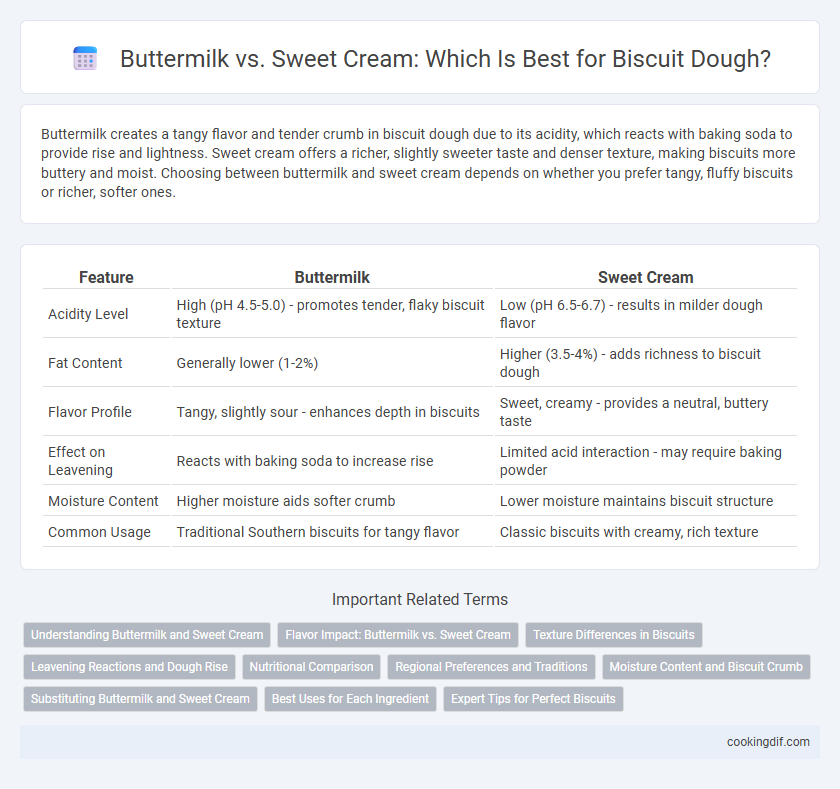Buttermilk creates a tangy flavor and tender crumb in biscuit dough due to its acidity, which reacts with baking soda to provide rise and lightness. Sweet cream offers a richer, slightly sweeter taste and denser texture, making biscuits more buttery and moist. Choosing between buttermilk and sweet cream depends on whether you prefer tangy, fluffy biscuits or richer, softer ones.
Table of Comparison
| Feature | Buttermilk | Sweet Cream |
|---|---|---|
| Acidity Level | High (pH 4.5-5.0) - promotes tender, flaky biscuit texture | Low (pH 6.5-6.7) - results in milder dough flavor |
| Fat Content | Generally lower (1-2%) | Higher (3.5-4%) - adds richness to biscuit dough |
| Flavor Profile | Tangy, slightly sour - enhances depth in biscuits | Sweet, creamy - provides a neutral, buttery taste |
| Effect on Leavening | Reacts with baking soda to increase rise | Limited acid interaction - may require baking powder |
| Moisture Content | Higher moisture aids softer crumb | Lower moisture maintains biscuit structure |
| Common Usage | Traditional Southern biscuits for tangy flavor | Classic biscuits with creamy, rich texture |
Understanding Buttermilk and Sweet Cream
Buttermilk, a tangy, fermented dairy product with a lower fat content, contributes to tender biscuits by reacting with baking soda to create a light, fluffy texture. Sweet cream, the unfermented fresh cream rich in fat, enhances biscuit dough by adding moisture and richness, resulting in a denser, more buttery biscuit. Understanding the distinct acidity and fat levels of buttermilk versus sweet cream helps bakers choose the ideal ingredient for desired biscuit crumb and flavor.
Flavor Impact: Buttermilk vs. Sweet Cream
Buttermilk imparts a tangy, slightly acidic flavor that enhances the biscuit's depth and balances its richness, creating a tender crumb with subtle complexity. Sweet cream, with its mild sweetness and creamy undertones, produces a softer, more buttery flavor profile, resulting in a richer, slightly sweeter biscuit. The choice between buttermilk and sweet cream significantly influences the biscuit's taste, texture, and overall sensory experience.
Texture Differences in Biscuits
Buttermilk creates a tender and flaky biscuit texture due to its acidity, which reacts with baking soda to produce a light rise and delicate crumb structure. Sweet cream yields a richer, denser biscuit with a buttery flavor and more uniform crumb, as it lacks the acidic component that affects leavening. The choice between buttermilk and sweet cream directly impacts biscuit softness, flakiness, and rise, with buttermilk being preferred for lighter, fluffier results.
Leavening Reactions and Dough Rise
Buttermilk contains lactic acid that reacts with baking soda to produce carbon dioxide, resulting in a faster and more vigorous leavening reaction that yields a tender, flaky biscuit texture. Sweet cream lacks this acidity, relying primarily on baking powder for leavening, which produces a more gradual rise and slightly denser crumb. The acidity in buttermilk enhances gluten development and enzyme activity, promoting a lighter and more aerated dough rise compared to sweet cream.
Nutritional Comparison
Buttermilk contains lower fat and fewer calories compared to sweet cream, making it a lighter option for biscuit dough. It is rich in probiotics and calcium, which support digestive health and bone strength. Sweet cream offers higher fat content, contributing to richer flavor and tenderness but with increased saturated fat and calorie levels.
Regional Preferences and Traditions
Buttermilk biscuit dough is favored in Southern United States for its tangy flavor and tender texture, often linked to traditional Southern cooking. Sweet cream biscuit dough, preferred in Northern regions, offers a richer, milder taste and a fluffier crumb, aligning with tastes in areas with dairy farming. Regional preferences reflect historical availability of buttermilk in the South and fresh cream in the North, shaping distinct biscuit traditions across the country.
Moisture Content and Biscuit Crumb
Buttermilk biscuit dough typically has higher acidity and moisture content than sweet cream, which contributes to a tender, moist biscuit crumb with a slight tang. In contrast, sweet cream provides a richer, less acidic dough with lower moisture, resulting in a flakier, denser crumb texture. The elevated moisture in buttermilk promotes gluten development balance, yielding a fluffy and soft biscuit interior.
Substituting Buttermilk and Sweet Cream
Buttermilk and sweet cream differ in acidity and fat content, which impact biscuit dough texture and rise. When substituting buttermilk with sweet cream, adding a tablespoon of vinegar or lemon juice per cup can mimic acidity, ensuring proper leavening with baking soda. Replacing sweet cream with buttermilk may require reducing acidic ingredients to prevent over-tanginess, maintaining the biscuit's tender crumb and flavor balance.
Best Uses for Each Ingredient
Buttermilk is ideal for biscuit dough due to its acidity, which reacts with baking soda to create tender, flaky layers and a tangy flavor perfect for savory biscuits. Sweet cream adds a richer, buttery taste and produces a denser, golden-brown texture suited for sweeter or more decadent biscuits. Choosing between buttermilk and sweet cream depends on the desired biscuit crumb, flavor profile, and pairing preferences.
Expert Tips for Perfect Biscuits
Buttermilk lends biscuits a tangy flavor and tender crumb due to its acidity reacting with baking soda, resulting in a light, fluffy texture favored by expert bakers. Sweet cream produces a milder taste with a slightly denser crumb, preferred for a richer, buttery biscuit profile. Experts recommend buttermilk for classic, airy biscuits while sweet cream suits those seeking a subtle sweetness and golden finish.
Buttermilk vs sweet cream for biscuit dough Infographic

 cookingdif.com
cookingdif.com